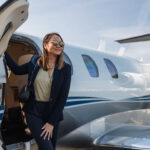Flying with Family & Friends
With the holidays quickly approaching many pilots, especially those with roots in general aviation, choose to fly with family and friends. There are a handful of tips, tricks, and important reminders that can help such flights go more smoothly that are worth keeping in mind.
General Safety Considerations
The Federal Aviation Administration (FAA) recommends pilots reference 14 CFR 91.519 for general aviation briefing guidance. Indeed, there are a number of briefing items the FAA has deemed essential. The first non-negotiable briefing topic is seatbelts. The FAA notes that seatbelts are “explicitly” required per the regulations. This briefing item is comprised of two requirements. Passengers must be informed of how the seatbelt works and they must be notified of the requirement for all seatbelts to be fastened.
Air is another essential briefing item. The FAA recommends that pilots show where air vents are located and consider discussing the potential of airsickness with new passengers. Other items pilots will want to cover include fire extinguishers, exits, emergencies, equipment, traffic and talking. These briefing items are imperative because they all relate to safety. Passengers need to be informed of fire extinguisher location and use, as well as egress order and method. Pilots also need to discuss the importance of a sterile cockpit during critical phases of flight. The last, but still important, consideration to take into account is the questions passengers may have. All of the briefed information, especially for lesser experienced passengers, may be overwhelming. As the PIC it is important to be sympathetic to passenger concerns and reassuring. It should be everyone’s goal to ensure their passengers, feel safe and informed.
Traveling with Children
For those of us traveling with young children here are a few notable pointers that will hopefully prove helpful. Firstly, children experience the same physiological effects as adults when flying. However, unlike adults, they may not be able consciously identify or mitigate them. The most obvious example of this is clearing one’s ears. Ear pressure issues are less likely to occur when there is jaw movement. So, for toddler aged children and younger a pacifier is a good option to help prevent blockages. Older kids may benefit from a piece of gum or even chewy candy. Hearing protection is important too. While some kids may do ok without having an actual headset to tie them into the conversation others may want or need to be included to feel secure. Regardless of whether or not used for simple hearing protection or as an actual headset, ensuring a proper fit is vital. Many hearing protection and headset companies offer sizing that is specifically designed for youth.
In regards to seatbelts and safety many car seats and booster seats can comfortably fit in smaller aircraft with minimal manipulation. Lastly, it’s important to keep in mind that that unlike car travel or a commercial airliner, children will need to stay seated without the option to move around for the entire flight period. The FAA goes into detail on the proper use of child restraint systems in aircraft through 14 CFR 91.107(a)(3). Approved seats manufactured in the U.S. will have two labels affixed attesting to their approval: (1) “THIS CHILD RESTRAINT SYSTEM CONFORMS TO ALL APPLICABLE FEDERAL MOTOR VEHICLE SAFETY STANDARDS.” and (2) “THIS RESTRAINT IS CERTIFIED FOR USE IN MOTOR VEHICLES AND AIRCRAFT.” If the seat doesn’t have these labels or a foreign government equivalent indicating it was manufactured under the United Nations standards, then it cannot be used in the aircraft.
Happy Holidays
Pilots are uniquely adept when it comes to traveling and the associated trip demands. Regardless of how you travel over the holidays, remember to stay safe and use the knowledge gained from flying to ease your travel burdens. Wishing everyone the happiest of holidays!
RELATED CTS TRAINING










